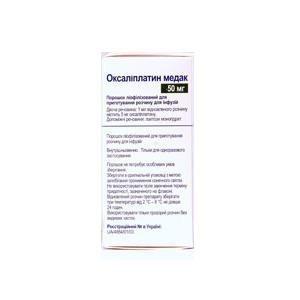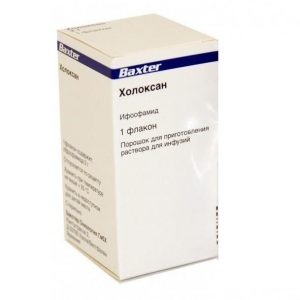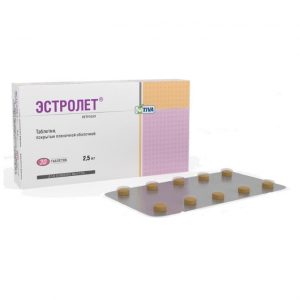Description
Release form
Film-coated tablets.
Packing
30 pcs
Pharmacological action of
Pharmacodynamics
Antitumor drug. A highly selective non-steroidal inhibitor of aromatase, an enzyme with which in postmenopausal women, androstenedione in peripheral tissues is converted to estrone and then to estradiol. Anastrozole does not have gestagenic, androgenic and estrogenic activity.
In postmenopausal women, anastrozole in a daily dose of 1 mg causes an 80% decrease in estradiol levels. Anastrozole in daily doses up to 10 mg has no effect on the secretion of cortisol and aldosterone.
Pharmacokinetics
Absorption and distribution of
Anastrozole after oral administration on an empty stomach is quickly absorbed from the digestive tract. Cmax in plasma is reached within 2 hours. Food slightly reduces the absorption rate (but not its degree) and does not lead to a clinically significant effect on plasma Css of the drug with a single dose of anastrozole. After a 7-day administration of anastrozole Css in plasma, approximately 90-95%. Binding to blood plasma proteins – 40%.
Metabolism and excretion sr
In postmenopausal women, anastrozole in a daily dose of 1 mg causes an 80% decrease in estradiol levels. Anastrozole in daily doses up to 10 mg has no effect on the secretion of cortisol and aldosterone.
Pharmacokinetics
Absorption and distribution of
Anastrozole after oral administration on an empty stomach is quickly absorbed from the digestive tract. Cmax in plasma is reached within 2 hours. Food slightly reduces the absorption rate (but not its degree) and does not lead to a clinically significant effect on plasma Css of the drug with a single dose of anastrozole. After a 7-day administration of the drug Css, anastrozole in plasma is approximately 90-95%. Binding to blood plasma proteins – 40%.
Metabolism and excretion sr
In postmenopausal women, anastrozole in a daily dose of 1 mg causes an 80% decrease in estradiol levels. Anastrozole in daily doses up to 10 mg has no effect on the secretion of cortisol and aldosterone.
Pharmacokinetics
Absorption and distribution of
Anastrozole after oral administration on an empty stomach is quickly absorbed from the digestive tract. Cmax in plasma is reached within 2 hours. Food slightly reduces the absorption rate (but not its degree) and does not lead to a clinically significant effect on plasma Css of the drug with a single dose of anastrozole. After a 7-day administration of the drug Css, anastrozole in plasma is approximately 90-95%. Binding to blood plasma proteins – 40%.
Metabolism and excretion sr Anastrozole in daily doses up to 10 mg has no effect on the secretion of cortisol and aldosterone.
Pharmacokinetics
Absorption and distribution of
Anastrozole after oral administration on an empty stomach is quickly absorbed from the digestive tract. Cmax in plasma is reached within 2 hours. Food slightly reduces the absorption rate (but not its degree) and does not lead to a clinically significant effect on plasma Css of the drug with a single dose of anastrozole. After a 7-day administration of the drug Css, anastrozole in plasma is approximately 90-95%. Binding to blood plasma proteins – 40%.
Metabolism and excretion sr Anastrozole in daily doses up to 10 mg has no effect on the secretion of cortisol and aldosterone.
Pharmacokinetics
Absorption and distribution of
Anastrozole after oral administration on an empty stomach is quickly absorbed from the digestive tract. Cmax in plasma is reached within 2 hours. Food slightly reduces the absorption rate (but not its degree) and does not lead to a clinically significant effect on plasma Css of the drug with a single dose of anastrozole. After a 7-day administration of the drug Css, anastrozole in plasma is approximately 90-95%. Binding to blood plasma proteins – 40%.
Metabolism and excretion sr Cmax in plasma is reached within 2 hours. Food slightly reduces the absorption rate (but not its degree) and does not lead to a clinically significant effect on plasma Css of the drug with a single dose of anastrozole. After a 7-day administration of the drug Css, anastrozole in plasma is approximately 90-95%. Binding to blood plasma proteins – 40%.
Metabolism and excretion sr Cmax in plasma is reached within 2 hours. Food slightly reduces the absorption rate (but not its degree) and does not lead to a clinically significant effect on plasma Css of the drug with a single dose of anastrozole. After a 7-day administration of the drug Css, anastrozole in plasma is approximately 90-95%. Binding to blood plasma proteins – 40%.
Metabolism and excretion
Anastrozole metabolism is carried out by N-dealkylation, hydroxylation and glucuronidation. Triazole, a major plasma metabolite, does not inhibit aromatase.
T1 / 2 from plasma is 40-50 hours. Less than 10% of the dose is excreted unchanged in the urine within 72 hours after taking the drug. Metabolites are excreted mainly in the urine.
Pharmacokinetics in special clinical cases
The clearance of anastrozole after oral administration for cirrhosis of the liver or impaired renal function does not change.
Indications
Common breast cancer in postmenopausal women.
Contraindications
Severe renal failure (CC <20 ml / min) moderate or severe hepatic insufficiency (safety and efficacy of the drug have not been established) concomitant therapy with tamoxifen premenopause pregnancy maternity sardlkp or other components of the drug. Use during pregnancy and lactation The use of the drug during pregnancy and during breastfeeding is contraindicated. Composition 1 tablet contains: Active substances: anastrozole 1 mg. Excipients: lactose monohydrate 72 mg, microcrystalline cellulose 15.6 mg, povidone 3 mg, magnesium stearate 0.9 mg, colloidal silicon dioxide 0.5 mg, sodium carboxymethyl starch 2 mg. Composition of the film coat: hypromellose 1.65 mg, macrogol-4000 0.45 mg, titanium dioxide 0.9 mg. Dosage and administration of Adults, including for elderly patients, the drug should be taken orally at the same time, 1 mg each (swallow the whole tablet with water) 1 time / day for a long time. If signs of disease progression appear, the drug should be discontinued. Dose adjustment in patients with mild to moderate impaired renal function is not required. Dose adjustment in patients with mild hepatic impairment is not required. Side effects Determination of the frequency of adverse reactions: very often (> 10%)
often (1-10%)
rare (0.1-1%)
very rare (< 0.1%). From the reproductive system: often – vaginal dryness rarely – vaginal bleeding (mainly during the first weeks after cancellation or change of previous hormonal therapy to anastrozole). From the digestive system: often – nausea, diarrhea rarely – anorexia, vomiting, increased activity of GGT and alkaline phosphatase. From the cardiovascular system: very often – hot flashes. From the side of the central nervous system: often – headache rarely – drowsiness. Co side of the musculoskeletal system: often – arthralgia. Dermatological reactions: often – thinning of the hair, skin rash is very rare – polymorphic erythema (Stevens-Johnson syndrome). From the side of metabolism: rarely – hypercholesterolemia is possible – a decrease in bone mineral density due to a decrease in the level of circulating estradiol (risk of osteoporosis, bone fractures). Other: often – asthenia is very rare – allergic reactions (including angioedema, urticaria, anaphylactic shock). overdose Symptoms: a single dose of anastrozole that could lead to life-threatening symptoms has not been identified. Treatment: In case of overdose, treatment should be symptomatic. If the patient is conscious, it is advisable to induce vomiting. General supportive therapy, patient monitoring, and monitoring of vital organs and systems are recommended. Dialysis may be performed. There is no specific antidote. Storage conditions Keep out of the reach of children, in a dry place at a temperature not exceeding 25 ° C. Expiration 2 years. Deystvuyuschee substances anastrozole dosage form dosage form tablets




